Whale-Watching, Juneau, Alaska
August 1, 2011

Bubble-Netting!
We took a whale-watching trip out from Juneau which exceeded our expectations! We had the privilege of watching about ten whales repeatedly surge from the surface in a foam of bubbles in a show of cooperative feeding. I have learned a lot about humpback whales from the Enchanted Learning website and a lot of the information below paraphrases that site.| Two of the whales from the group above demonstrate the feeding of these humpback whales. They are baleen whales, feeding by straining water through comb-like plates of baleen. This traps krill and small schooling fish. You can see the baleen slots of the whales at right. The humpback whale has about 330 pairs of dark gray baleen plates with coarse gray bristles hanging from the jaws. They are about 25 inches long and 13.5 inches wide. Humpback whales have 14-35 throat grooves that run from the chin to the navel. These grooves allow their throat to expand during the huge intake of water during filter feeding. They feed by gulping - you can see that the one at the extreme left has made such a big gulp that its throat almost makes a sphere - like a bullfrog. After they make the bubble net, they apparently charge the surface with their mouths wide open. |  |
An average-sized humpback whale will eat about 2 tons of plankton, krill and small, schooling fish each day during the feeding season in cold waters (about 120 days). The literature says they eat twice a day, so we were fortunate to happen on the evening feeding time.
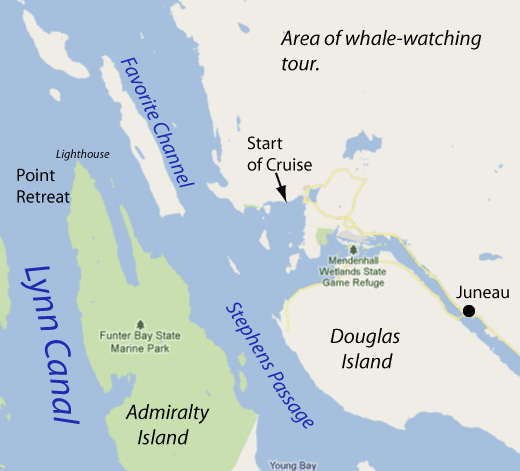 | After our trip to the Mendenhall Glacier, our driver returned for us and took us to the marina where our whale-watching tour began. It was raining and foggy, so I have to admit to some pessimism about seeing anything. 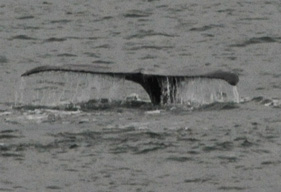 But after a cruise out into fairly open water, we began to see whale backs and blowing, and an occasional fluke display. So I began to sit up and take notice. |
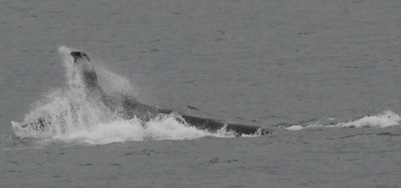 | 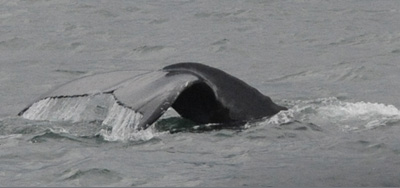 |
We came upon this mother and baby whale, and when Mom would dive, the calf would stay on the surface and play. It was a good show.
 | 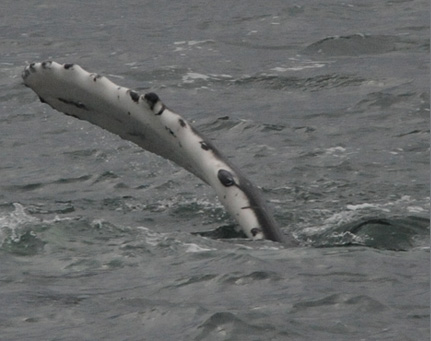 |
The young one would occasionally stick his nose out of the water, as if to see if we were watching, and then he would go back to active play. This is called "spyhopping" where they poke their heads out of the water for up to 30 seconds to take a look around. Humpbacks have huge, mottled white flippers with rough edges that are up to one-third of its body length; these are the largest flippers of any whale.
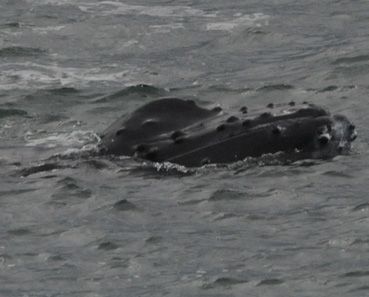 | 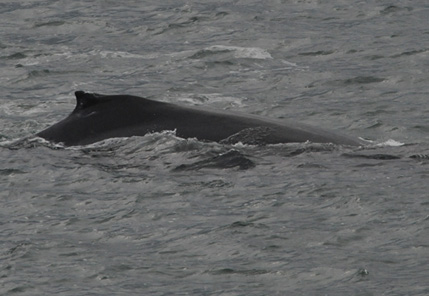 |
Typically we would see the head, and then the back as he rolled his head downward. The small round bumps on the front of the head are called knobs or tubercles, edging the jaws. At right above, it is "humpbacking", the characteristic humping that gives this species its name.
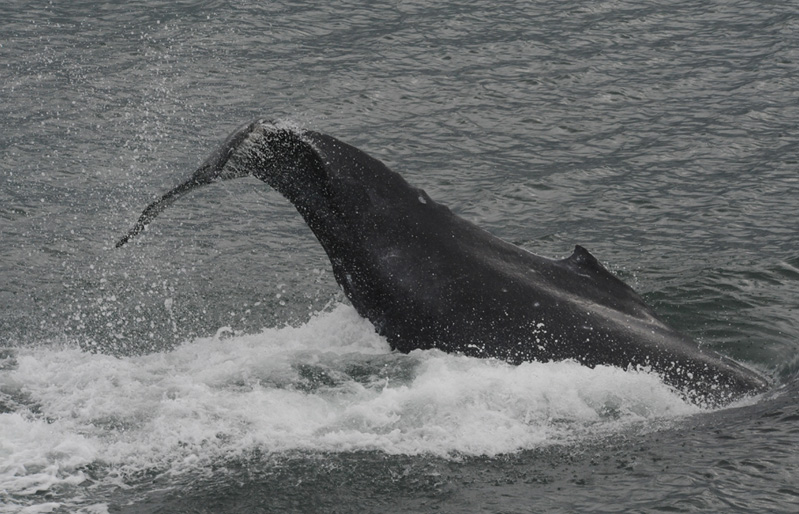
Occasionally he would do something more dramatic with his fluke. This may be an example of what is called "lobtailing" when humpbacks stick their tail out of the water into the air, swing it around, and then slap it on the water's surface. It makes a very loud sound. The meaning or purpose of lobtailing is unknown, but may be done as a warning to the rest of the pod. Humpbacks lobtail more when the seas are rough and stormy. Slapping a fin against the surface of the water is another unexplained humpback activity.
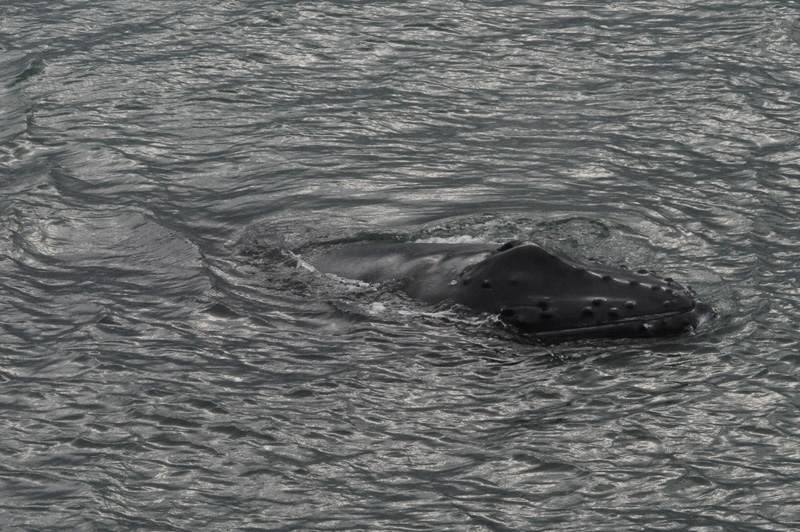

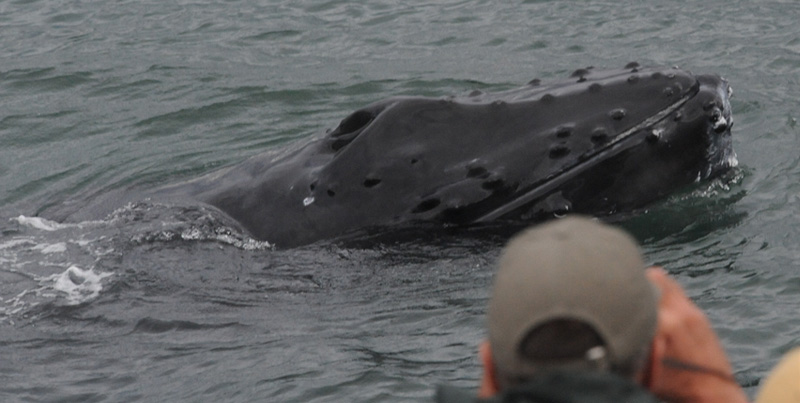
The young one became curious enough that he actually came over and brushed up against the back of the boat!
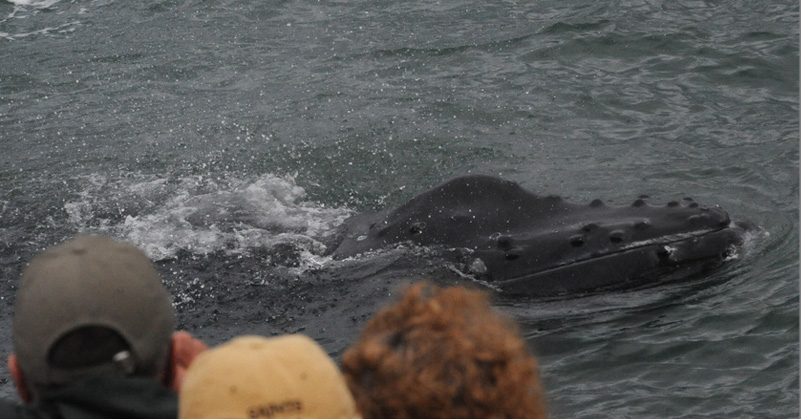
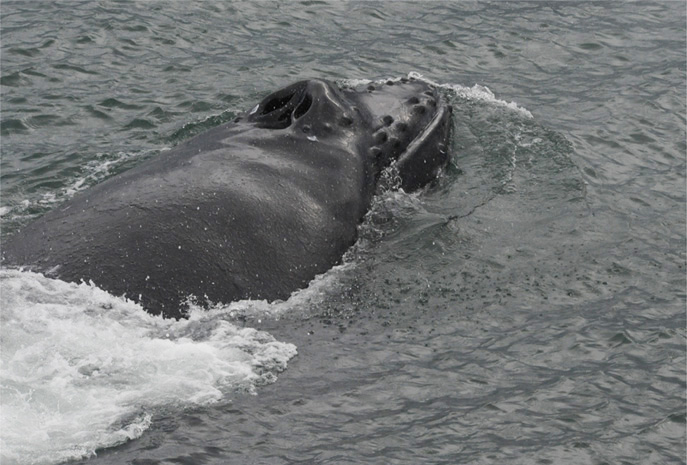 | After coming over to our boat and actually nosing up against it, the baby whale continues to play around on the surface. Mom is below fishing. The captain said that was the first time a whale had actually come over and touched his boat. |

The mother whale dives again. We were close enough to appreciate the great size of the whale. The great tail fin (fluke) is deeply-notched and up to 12 feet wide. The fluke gives powerful thrust for swimming. Humpbacks have a small dorsal fin toward the flukes. The average adult female is close to 50 ft long and weighs 35 tons. The male is somewhat smaller at 46 ft and 25 tons.
 | We reached the Point Retreat Lighthouse on this lonely point. There was no other evidence of human habitation in view except a floating channel marker. |
We got some respite from the rain, but this shower did not miss us! If you were going to photograph whales, you had to take the weather. 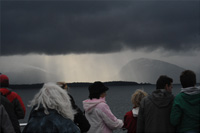 | 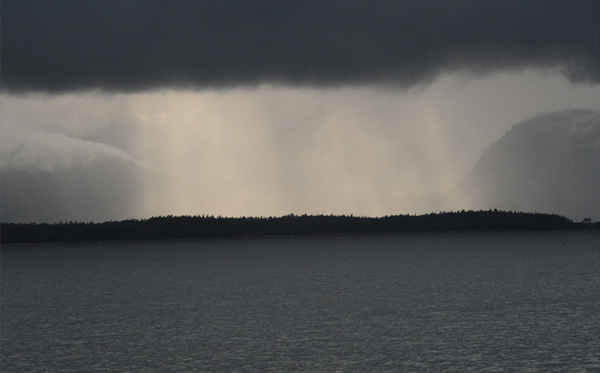 |
 | A channel marker close to the lighthouse was a resting place for some sleepy-looking Stellar sea lions. Perhaps they had had a good day of fishing and had full tummies. The average male sea lion weighs about 1250 pounds, twice the weight of a female. The male is about 10ft long. |
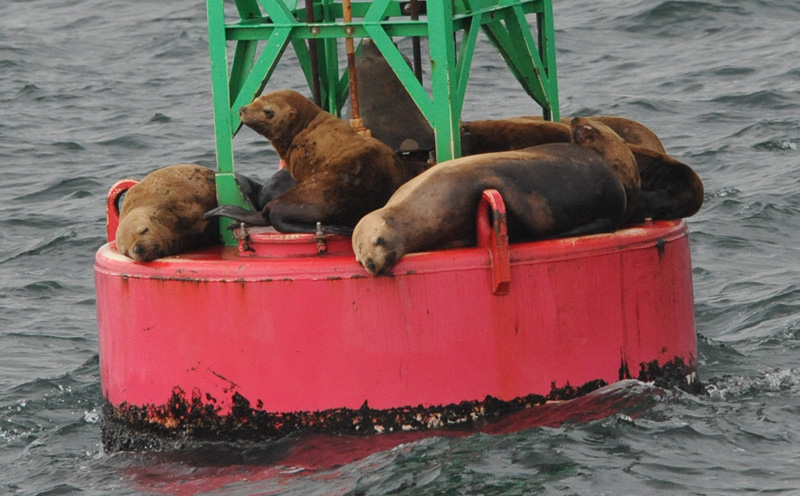
It's bad enough to have to sleep on this cold metal buoy, rocking in the waves. Now we've got all these strange creatures staring at us!
 | 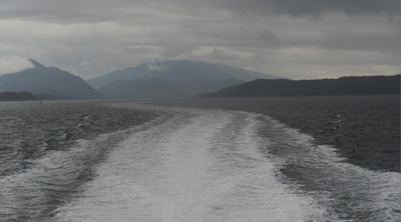 |
 | We were certainly getting some Alaska summer weather, but nobody was complaining because of all the things we got to see. There was a glacier out there, shrouded in cloud. |
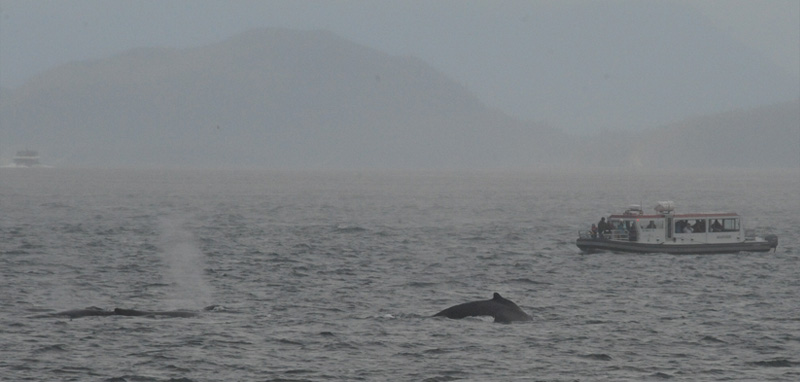
It was worth braving the rain to see the action on the bay.
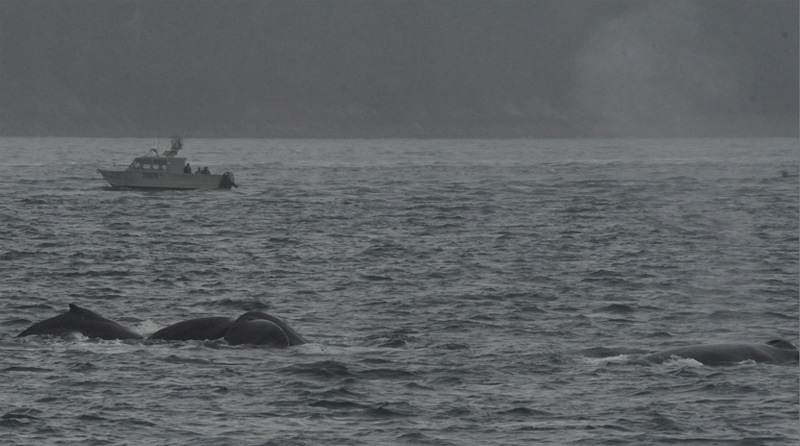
We started to see more cooperative effort among the feeding whales. Here one is just rolling into a dive, a second is showing its fluke, and a third is blowing.
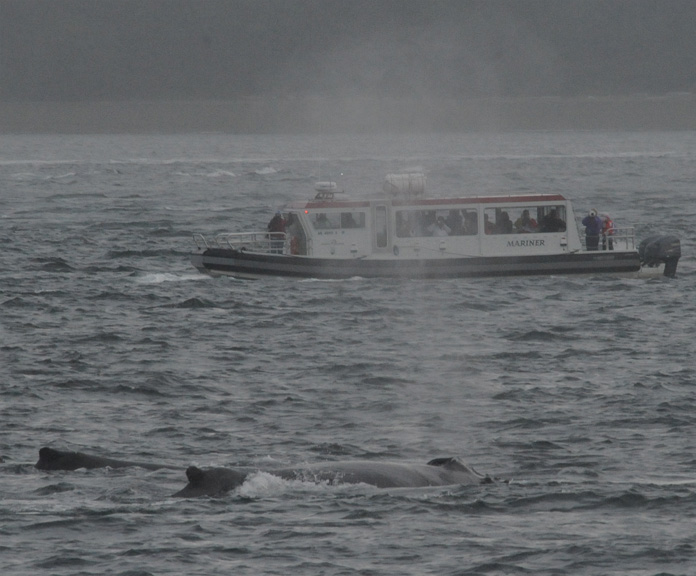 | The folks in this nearby boat get a close view of a powerful blow by this whale. In response to the gathering of whales, several boats were now around. We definitely noted that they blew more often immediately after their deep dives and surfacing. |
Great fluke action with this one. | 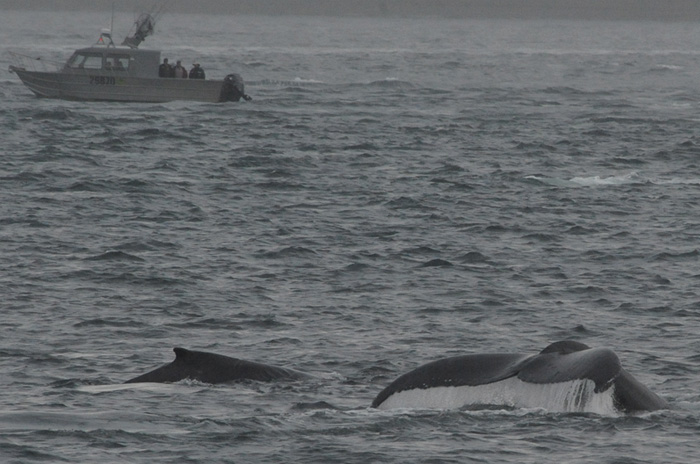 |
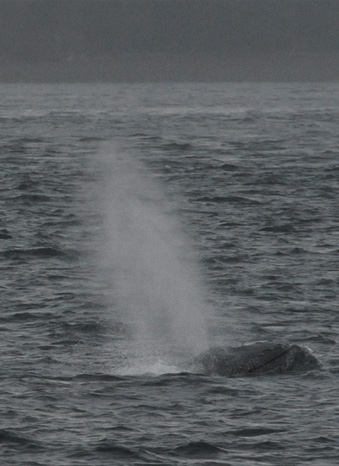 | 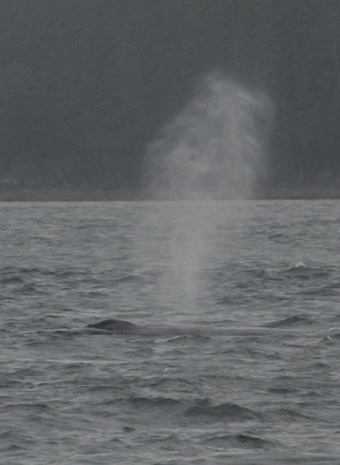 | |
Humpback whales breathe air at the surface of the water through 2 blowholes located near the top of the head. They spout (breathe) about 1-2 times per minute at rest, and 4-8 times per minutes after a deep dive. Their blow is a double stream of spray that rises 10-13 feet above the surface of the water. Humpback whales can dive for up to 30 minutes, but usually last only up to 15 minutes. Humpbacks can dive to a depth of 500-700 feet.
 | 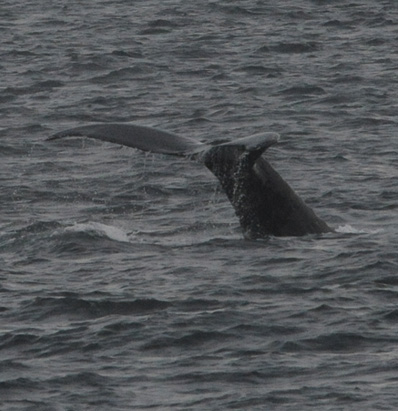 |
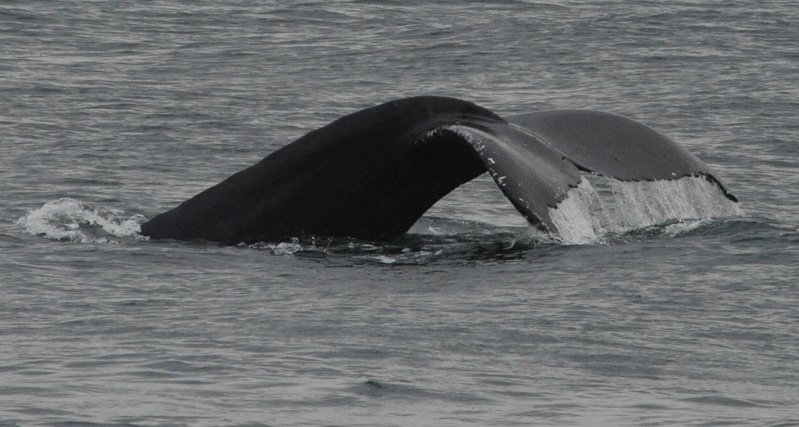
I was fascinated by the kinds of water streaming you got from the flukes.

We encounter another Mom and babe. Mom surfaces, perhaps to see how junior is behaving, and then promptly dives again. | 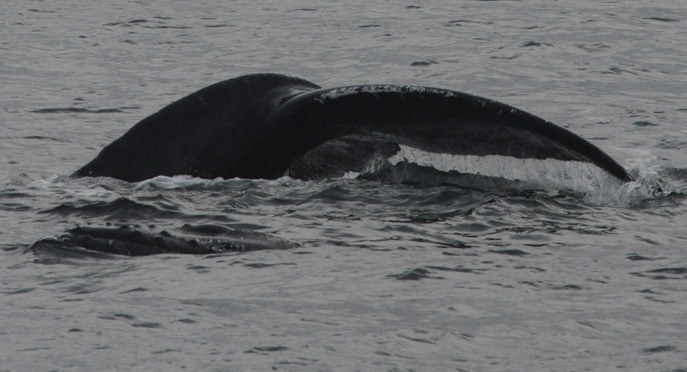 |
Humpbacks travel in large, loose groups. Most associations between humpbacks are temporary, lasting at most a few days. The exception is the strong and lasting bond between mother and calves.
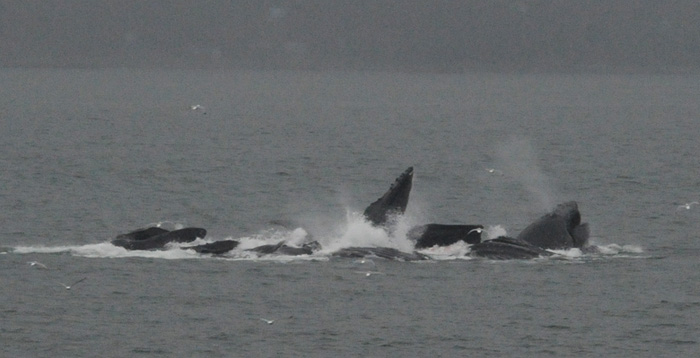 | I felt very blessed with what we had seen, but there was more to come. Several hundred yards from the boat we saw a surge of numerous whales through the surface in a foam of bubbles. It was my first time to see bubble-netting in person. |
Humpbacks cooperate in hunting and have developed a method of rounding up highly concentrated masses of prey that is called bubble-net feeding. The hunting members of a pod form a circle 10-100 feet across and about 50 feet under the water. Then the humpbacks blow a wall of bubbles as they swim to the surface in a spiral path. The cylindrical wall of bubbles makes the trapped krill, plankton, and/or small fish move to the surface of the water in a giant, concentrated mass. Then as shown at the top, the humpbacks charge toward the surface with their mouths open.
When the surging whales fell back, they worked the water for more food and were joined by a flock of seagulls. |  |
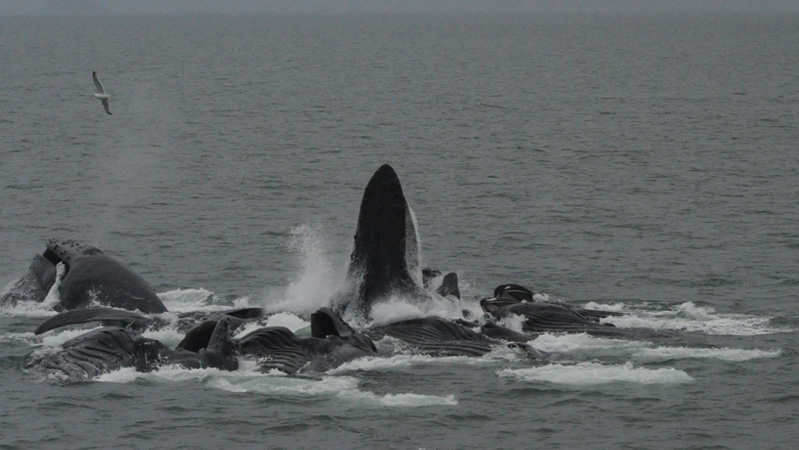
Again we saw the great surge as the 10 whales break the surface in a foam of bubbles.
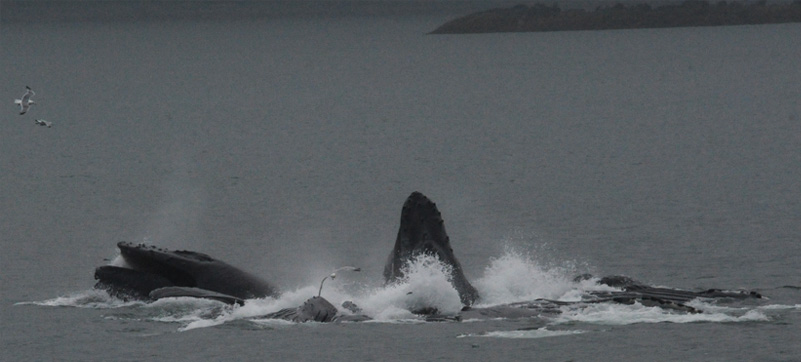
Again the great surge comes! We were all waiting and watching, and a cheer went up when the surge came. They came at about three minute intervals, and you could envision the whales diving and setting up their formation and then driving toward the surface. I saw a total of seven rounds of this. Remarkably the surges came at 7:30, 7:34, 7:37, 7:40, 7:43. There were also surges at 7:51 and 7:56, tapering off the three minute interval they had maintained for five cycles.
Of course we didn't know where they were going to come up, so I missed some of the surges with my camera. The naturalist on board was discussing the phenomenon with us and was very helpful. She gave us the tip to watch the birds, suggesting that when you see the birds gather and move down toward the surface, you can expect the surge. She also told us that the whales will gather a particular group, and if successful those same whales will get together the next year.
As we were returning to dock, even the crew was expressing amazement at how much we had seen.
| Return to Juneau |
2011
Inside Passage